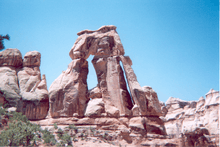Cedar Mesa Sandstone
| Cedar Mesa Sandstone Stratigraphic range: Early Permian, 286–245Ma | |
|---|---|
 Druid Arch in Canyonlands National Park, an eroded fin of Cedar Mesa Sandstone | |
| Type | Geological member[1] |
| Unit of | Cutler Formation |
| Underlies | Organ Rock Shale |
| Overlies |
Elephant Canyon Formation Halgaito Member |
| Lithology | |
| Primary | Sandstone |
| Location | |
| Coordinates | 37°23′N 109°55′W / 37.383°N 109.917°W |
| Region | Colorado Plateau |
| Country | United States |
| Type section | |
| Named for | Cedar Mesa |
| Named by |
Arthur A. Baker John B. Reeside, Jr., 1929 |
Cedar Mesa Sandstone (also known as the Cedar Mesa Formation) is a sandstone member[1] of the Cutler Formation, found in southeast Utah, southwest Colorado, northwest New Mexico, and northeast Arizona.[2]
Cedar Mesa Sandstone is the remains of coastal sand dunes deposited about 245–286 million years ago, during the early Permian period.[3] Coloration varies, but the rock often displays a red and white banded appearance as a result of periodic floods which carried iron-rich sediments down from the Uncompahgre Mountains during its formation.[3][4]
Named after Cedar Mesa near the San Juan River in Utah,[2] exposures of Cedar Mesa Sandstone form the spires and canyons found in the Needles and Maze districts of Canyonlands National Park,[3] the inner gorge of White Canyon,[5] and the three natural bridges of Natural Bridges National Monument.[6]
See also
Notes and references
- ↑ 1.0 1.1 The Cutler Formation is sometimes classified as the Cutler Group, in which case Cedar Mesa Sandstone is classified as a formation rather than a member.
- ↑ 2.0 2.1 "Cedar Mesa Sandstone". Park Stratigraphy of the Colorado Plateau. United States Geological Survey. Retrieved 25 November 2009.
- ↑ 3.0 3.1 3.2 "Canyonlands National Park - Cedar Mesa Sandstone". National Park Service. Retrieved 25 November 2009.
- ↑ "Canyonlands National Park - Geologic Formations". National Park Service. Retrieved 26 November 2009.
- ↑ "Geological Survey Circular 217 - Preliminary Report on the White Canyon Area, San Juan County, Utah". United States Geological Survey. Retrieved 25 November 2009.
- ↑ "Natural Bridges - Geology" (PDF). National Park Service. January 2003. Retrieved 25 November 2009.